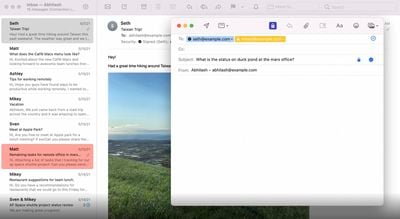macOS Monterey to Support All-New Mail App Extensions, Plug-Ins Will Stop Functioning in Future Release
As part of WWDC this week, Apple introduced a new MailKit framework for macOS Monterey that enables developers to create Mail app extensions that block content, perform message and composing actions, and help with security.

There will be four main categories of Mail app extensions, according to Apple:
- Compose: Extensions that provide new workflows when composing emails
- Actions: Extensions that apply custom rules to incoming emails, such as an email being color coded, moved to a separate inbox, marked as read, or flagged
- Content Blocking: Extensions that serve as WebKit content blockers for emails based on specific criteria in an email's HTML code
- Message Security: Extensions that sign, encrypt, and decrypt emails when sending and receiving mail, with signed and encrypted icons below emails
Xcode 13, available in beta, includes a template for developers looking to create Mail app extensions on the Mac. The extensions can be built into existing Mac apps and can also be distributed through the Mac App Store, according to a WWDC session about MailKit, which is available on macOS only and not iOS or iPadOS.
In the WWDC session, Apple indicated that older Mail app plug-ins will stop functioning in an unspecified future macOS release.
macOS Monterey is available now in beta for developers, with a public beta to follow in July.
Popular Stories
2024 is just a few days away, and there are many iOS 17 and iOS 18 features that are expected to launch throughout the year. Below, we have recapped new iOS features expected in 2024, including Stolen Device Protection, collaborative Apple Music playlists, AirPlay on hotel room TVs, app sideloading in the EU, next-generation CarPlay, roadside assistance via satellite outside of the U.S., RCS ...
Apple released the first beta of iOS 17.3 earlier this month, and the upcoming software update includes two new features so far. iOS 17.3 will likely be released in January like iOS 16.3 and iOS 15.3 were, but February is also a possibility if testing is prolonged. Below, we provide additional details about the new features in iOS 17.3 so far. Stolen Device Protection Earlier this...
Apple's iPhone development roadmap runs several years into the future and the company is continually working with suppliers on several successive iPhone models concurrently, which is why we sometimes get rumored feature leaks so far ahead of launch. The iPhone 17 series is no different, and already we have some idea of what to expect from Apple's 2025 smartphone lineup. If you plan to skip...
Inverse's Raymond Wong today published an in-depth overview of Apple's increasing push towards high-end gaming on the Mac. The story includes commentary from Apple marketing managers Gordon Keppel and Leland Martin. One of the biggest reasons that gaming has improved on the Mac in recent years is the switch from Intel processors to Apple silicon, resulting in MacBooks providing...
Apple Watch Series 9 and the Apple Watch Ultra 2 are back in some of Apple's retail stores in the United States today, according to Bloomberg's Mark Gurman. Select stores will have availability today, while all stores will have the Apple Watch models back in stock by December 30. Online sales of the devices are set to resume tomorrow by 12:00 p.m. Pacific Time. Apple is able to begin selling ...
Apple's iPhones include several headline camera features that are worth using, such as Portrait Mode and Photographic Styles. But if all you want to use is the standard photo mode, there are still several tools and settings that can improve the composition of your pictures and help you capture the perfect shot using more traditional techniques. Whether you are the owner of a new iPhone or a...
The ban on imports of Apple Watch Series 9 and Apple Watch Ultra 2 models has today been temporarily paused, meaning that the devices can now go back on sale for a short while longer in the United States. Apple filed an emergency request to the United States Court of Appeals following President Biden's decision to decline a veto on the sales ban, allowing it to take effect earlier this week. ...




















Top Rated Comments
As for the mail plug-ins, they were never a great solution. Apple will continually move away from systems like mail plug-ins that live in the memory space of another application to inter-application communication systems like extensions that allow an application to extend another application visually without sharing memory space MacOS Classic style. I, for one, am looking forward to having a mail extension system that provides a stable API and that doesn’t break with each point release.
But this is also a change that needed to occur. Previously, mail bundles would break between point releases. Not major releases, mere patches. Every time Mail.app got updated, these bundles needed to get updated, too, and, until they did, the bundles wouldn’t work. Now we have a stable API guaranteed not to break on point releases and that will likely be stable across multiple major releases. We’ll probably see more mail extensions as a result of this, while previously, it was only worth the effort to devs who were absolutely serious about email extensibility. This API could also be ported to MobileMail.app, which, until now, hasn’t had any extensibility (except maybe for jailbreaking, but even then, I don’t think Mail was a common target for jailbreakers looking to tweak the system).